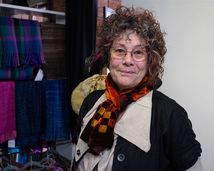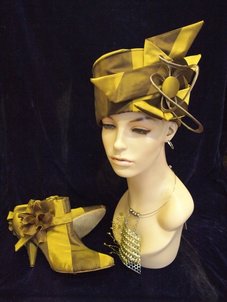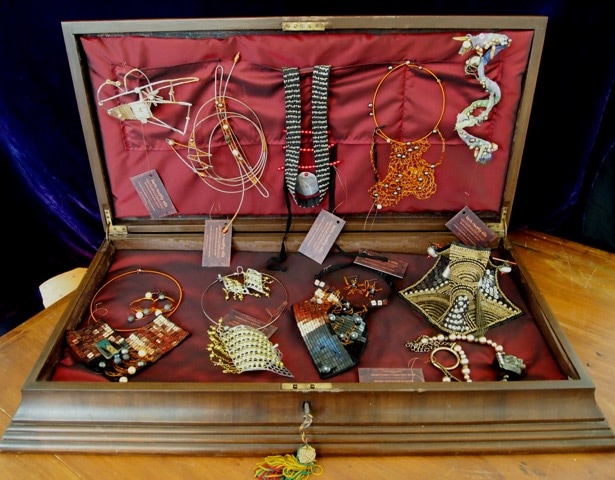 Karin Ellis
Karin Ellis By Liane Arno
CAN you imagine a childhood where you were made to stand in the corner and watch your school mates drink the precious milk that you had been denied because you have a German mother? A post-war Britain where you had to stand in the queue for hours clutching your ration book hoping that a piece of fruit would still be there when you got to the front? Where your parents, believing in the health effects of nudity, took you along to a nudist colony? A frightening place where neighbours murdered your cat because your family was a little out of the ordinary?
CAN you imagine a childhood where you were made to stand in the corner and watch your school mates drink the precious milk that you had been denied because you have a German mother? A post-war Britain where you had to stand in the queue for hours clutching your ration book hoping that a piece of fruit would still be there when you got to the front? Where your parents, believing in the health effects of nudity, took you along to a nudist colony? A frightening place where neighbours murdered your cat because your family was a little out of the ordinary?
Such are Karin Ellis’s early memories. Born of an Irish Guard and his prisoner of war German bride, Karin’s childhood was interesting, to say the least. The family settled in London after the war and Karin’s mother became a well-known artist’s model, modelling for the best teaching schools. Her diary was full. She was also a skilled dressmaker and pattern maker and she and Karin would spend many hours sewing. Her mother sewed garments for the family and Karin sewed costumes and hats for her teddies. Karin’s dad was somewhat artistic himself and painted murals up and down their staircase at home to add life to a council house. He was also a gifted embroiderer and transformed Karin’s grey corduroy jacket into a fire-breathing dragon covered in gold threads.
Growing up in this artistic household found Karin wanting to dance. But her parents wouldn’t let her travel alone to London’s ballet school. Too many young girls went missing in those early years after the war. It was only after the family emigrated to Australia that she was allowed to attend the local ballet school.
By this time Karin was 11 – and as she puts it, “long and gangly”. She went to be auditioned and got told to strip down to her singlet and knickers and perform. Given her passion for swimming and netball, her young frame was already developing musculature that was not suitable for a ballet dancer and she was told that she had to stop all sports if she was serious about dancing. She agreed and started at the beginning with a class of five-year-olds. She became besotted with dancing. Even on a trip back to England on a ship, she did her bar work on the ship’s rails.
She flew through the exams and her dance teacher gained permission from the Department of Education to take on the now 14-year-old for full time study. Every day of the week Karin would dance. Finally she was good enough to gain a small part in Giselle when the Australian Ballet toured Queensland. Her ballet teacher sought advice from the director as to whether Karin could gain entry into the Australian Ballet School. The response was not heartening. Not only was Karin thought to be tall but she was also too boisterous. The director feared that in a ballet scene where the four swans were looking ethereal she couldn’t trust Karin not to pull a face. “Why don’t you suggest to her that she do musical comedy?”
And so she did. She joined the cast of Sweet Charity in the first Australian production and spent her 16th birthday in rehearsals. It was here that she cemented her love of sewing and took on the challenges of costume design. Costumes not only need to be robust but they also need to look exquisite. Karin still recalls making G strings for the boys while sitting in the back of the theatre. She insists she did it without any measurements!
Growing up in this artistic household found Karin wanting to dance. But her parents wouldn’t let her travel alone to London’s ballet school. Too many young girls went missing in those early years after the war. It was only after the family emigrated to Australia that she was allowed to attend the local ballet school.
By this time Karin was 11 – and as she puts it, “long and gangly”. She went to be auditioned and got told to strip down to her singlet and knickers and perform. Given her passion for swimming and netball, her young frame was already developing musculature that was not suitable for a ballet dancer and she was told that she had to stop all sports if she was serious about dancing. She agreed and started at the beginning with a class of five-year-olds. She became besotted with dancing. Even on a trip back to England on a ship, she did her bar work on the ship’s rails.
She flew through the exams and her dance teacher gained permission from the Department of Education to take on the now 14-year-old for full time study. Every day of the week Karin would dance. Finally she was good enough to gain a small part in Giselle when the Australian Ballet toured Queensland. Her ballet teacher sought advice from the director as to whether Karin could gain entry into the Australian Ballet School. The response was not heartening. Not only was Karin thought to be tall but she was also too boisterous. The director feared that in a ballet scene where the four swans were looking ethereal she couldn’t trust Karin not to pull a face. “Why don’t you suggest to her that she do musical comedy?”
And so she did. She joined the cast of Sweet Charity in the first Australian production and spent her 16th birthday in rehearsals. It was here that she cemented her love of sewing and took on the challenges of costume design. Costumes not only need to be robust but they also need to look exquisite. Karin still recalls making G strings for the boys while sitting in the back of the theatre. She insists she did it without any measurements!
 Karin makes one-off pieces matched with a millinery piece and hand-covered shoes
Karin makes one-off pieces matched with a millinery piece and hand-covered shoes In Godspell she rummaged around op shops and found denim materials to remake into jeans, tops and bikinis. It was during this production that she met and married the bass player, then moved to South Gippsland and had two children.
A knee injury put paid to her professional dancing career. In order to get some income while the children were small she sewed toys – hundreds of them – for Billy Thorpe. That’s right. Billy Thorpe from the Aztecs set up a soft toy company (remember the Puggles?) and asked Karin to sew them for him.
But the passion to dance had not left Karin and she taught dance and performing arts at Leongatha Secondary College.
Concurrently she was approached to set up a ballet school and she jumped at the chance. After retraining for the Royal Academy of Dancing, she set up the school which required a 94 per cent pass rate for accreditation, Karin ran the school for 10 years. She would hold biannual productions and so it was back to op shops, this time ransacking them for autumnal colours to create the costumes for the seven dwarfs. Or bras – because they are perfect to suggest the scales of a lizard.
Now living in Wonthaggi, Karin makes one-off pieces that would make the haute couturiers of Paris proud. Each one is matched with a millinery piece and hand-covered shoes. She knits jewellery out of the copper wire of alternators – just because she likes the texture and the colour. She creates beautiful Cossack-style hats that make you wish for the cold so you could wear one.
Karin is probably the most creative person that I know – I can’t wait to see what she is making next.
You can see Karin Ellis’s work at Artspace Wonthaggi, McBride Avenue.
A knee injury put paid to her professional dancing career. In order to get some income while the children were small she sewed toys – hundreds of them – for Billy Thorpe. That’s right. Billy Thorpe from the Aztecs set up a soft toy company (remember the Puggles?) and asked Karin to sew them for him.
But the passion to dance had not left Karin and she taught dance and performing arts at Leongatha Secondary College.
Concurrently she was approached to set up a ballet school and she jumped at the chance. After retraining for the Royal Academy of Dancing, she set up the school which required a 94 per cent pass rate for accreditation, Karin ran the school for 10 years. She would hold biannual productions and so it was back to op shops, this time ransacking them for autumnal colours to create the costumes for the seven dwarfs. Or bras – because they are perfect to suggest the scales of a lizard.
Now living in Wonthaggi, Karin makes one-off pieces that would make the haute couturiers of Paris proud. Each one is matched with a millinery piece and hand-covered shoes. She knits jewellery out of the copper wire of alternators – just because she likes the texture and the colour. She creates beautiful Cossack-style hats that make you wish for the cold so you could wear one.
Karin is probably the most creative person that I know – I can’t wait to see what she is making next.
You can see Karin Ellis’s work at Artspace Wonthaggi, McBride Avenue.
